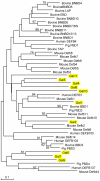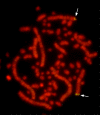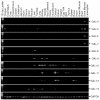A genome-wide screen identifies a single beta-defensin gene cluster in the chicken: implications for the origin and evolution of mammalian defensins
- PMID: 15310403
- PMCID: PMC515299
- DOI: 10.1186/1471-2164-5-56
A genome-wide screen identifies a single beta-defensin gene cluster in the chicken: implications for the origin and evolution of mammalian defensins
Abstract
Background: Defensins comprise a large family of cationic antimicrobial peptides that are characterized by the presence of a conserved cysteine-rich defensin motif. Based on the spacing pattern of cysteines, these defensins are broadly divided into five groups, namely plant, invertebrate, alpha-, beta-, and theta-defensins, with the last three groups being mostly found in mammalian species. However, the evolutionary relationships among these five groups of defensins remain controversial.
Results: Following a comprehensive screen, here we report that the chicken genome encodes a total of 13 different beta-defensins but with no other groups of defensins being discovered. These chicken beta-defensin genes, designated as Gallinacin 1-13, are clustered densely within a 86-Kb distance on the chromosome 3q3.5-q3.7. The deduced peptides vary from 63 to 104 amino acid residues in length sharing the characteristic defensin motif. Based on the tissue expression pattern, 13 beta-defensin genes can be divided into two subgroups with Gallinacin 1-7 being predominantly expressed in bone marrow and the respiratory tract and the remaining genes being restricted to liver and the urogenital tract. Comparative analysis of the defensin clusters among chicken, mouse, and human suggested that vertebrate defensins have evolved from a single beta-defensin-like gene, which has undergone rapid duplication, diversification, and translocation in various vertebrate lineages during evolution.
Conclusions: We conclude that the chicken genome encodes only beta-defensin sequences and that all mammalian defensins are evolved from a common beta-defensin-like ancestor. The alpha-defensins arose from beta-defensins by gene duplication, which may have occurred after the divergence of mammals from other vertebrates, and theta-defensins have arisen from alpha-defensins specific to the primate lineage. Further analysis of these defensins in different vertebrate lineages will shed light on the mechanisms of host defense and evolution of innate immunity.
Figures






References
Publication types
MeSH terms
Substances
LinkOut - more resources
Full Text Sources
Other Literature Sources
Molecular Biology Databases

